#DOSBox emulator
Explore tagged Tumblr posts
Text
DOSBox for Windows
Remember the good old days when x86 chips powered computers and MS-DOS ruled the operating system world? Back then, mastering a computer required a solid grasp of technical knowledge. For those who cherish nostalgia or wish to explore the roots of PC gaming and software, DOSBox provides an excellent opportunity to revisit that era. DOSBox is a versatile and powerful emulator that enables users to…
#best DOS emulator for macOS#DOS gaming nostalgia#DOSBox emulator#DOSBox networking features#DOSBox tutorial for beginners#how to use DOSBox#open-source DOS emulator#retro gaming with DOSBox#run DOS games on Windows
0 notes
Text



Did you know exoDOS ?
"eXoDOS is an attempt to catalog, obtain, and make playable every game developed for the DOS and PC Booter platform. We strive to find original media rather than using scene rips or hacks. This collection uses DOSBox to allow these older games to play on modern systems. Games supported by ScummVM give the user a choice between emulators. All required emulators are included and have been setup to run all included titles with no prior knowledge or experience required on the user's part."
#exodos#dosbox#retro gaming#emulation#launcher#80's#80s gaming#90s gaming#scummvm#1980s#vintage gaming#lucas arts#monkey island#point & click#80's tech#80s computers#graphic cards#sound card#emulator#dos games#peter molyneux
35 notes
·
View notes
Text
A mixture of early and core zoomer. I played Just Dance all of the time, and Minecraft when my parents got an Xbox.

#And Windows XP (my dad liked messing around with DOSbox emulators so I played Wolfenstein 3D a lot)#And the a variation of a Gameboy Emulator (I loved pokemon red)#But Minecraft and the Wii are still my first memories
12K notes
·
View notes
Text
THE AESTHETICS OF ABANDONWARE: WHY DEAD SOFTWARE FEELS HOLY
By R A Z, Queen of Glitches, Rat Prophet of the Post-Crash Pixel-Chapel
INTRO: Oi, you ever boot up a DOSBox emulator and feel your soul whisper "Amen"? No? Then saddle up, you absolute fetus, 'cause we’re going full pilgrimage through the haunted cathedrals of dead code, cursed shareware, and disc rot salvation. This is for the ones who dream in .BMPs, weep in MIDI, and hit “Yes to All” when copying cracked ZIPs from forgotten FTPs at 3AM. Abandonware ain’t just nostalgia—it’s digital necromancy. And some of us are bloody good at it.
DEAD SOFTWARE = HOLY SHRINE
Let’s be clear: abandonware is software that’s been, well, abandoned. The devs moved on. The publisher collapsed in a puff of VC smoke. The website's now a spammy shell selling beard oil or crack cocaine. The software? Unupdated. Unsupported. Gloriously obsolete.
So why does launching Hover! or Starship Titanic in 2025 feel like entering a chapel with weird lighting and a dial-up modem choir?
Because it’s sacred, mate.
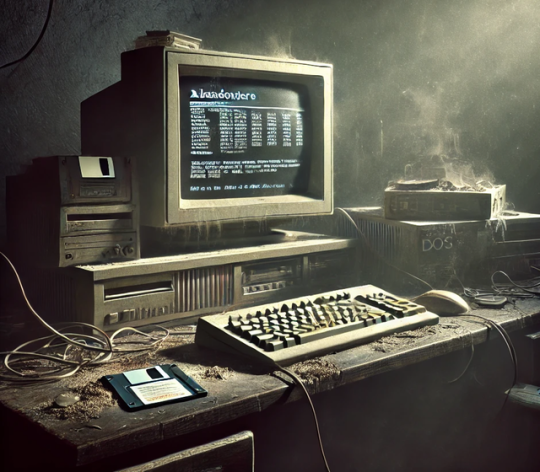
We’re not talking about the games themselves being perfect. A lot of them were janky as hell. We’re talking vibe. These programs exist outside capitalism now. They’re post-market. Post-hype. They don’t want your money, your updates, your logins. They just want your attention—pure and simple. You’re not a user anymore. You’re a curator. A digital monk brushing dust off EXEs and praying to the Gods of IRQ Conflicts and SoundBlaster settings.
WHY IT HITS DIFFERENT
Dead software doesn’t update. It doesn’t push patches or ads. It won’t ask you to connect your Google account to play Math Blaster. It’s a sealed time capsule. Booting it up is like receiving an artifact from a parallel dimension where the internet still had webrings and every kid thought Quake mods would lead to a dream job at ID Software.
But it also represents a lost sincerity. These weren’t games made to hook you for eternity with algorithms. These were games made by six dudes in a shed with a caffeine problem and one working CD burner. And their README files were poetry. Half of them end with “Contact us on AOL or send a floppy to our PO Box.” What do you mean you don’t know what a PO Box is?
FOR THE ZOOMIES: YOU JUST MISSED THE GOLDEN ROT
Listen up, juniors. If you were born after 2005, you missed the age when the internet was held together with chewing gum, JPEG artifacts, and unspoken respect.
Back then, finding a rare game was an adventure. Not an algorithm. You didn’t scroll TikTok and get spoon-fed vibes. You climbed through broken Geocities links and begged on IRC channels. You learned to read. You learned to search. You learned that “No-CD crack” doesn’t mean what your mum thinks it means.
So here’s your initiation: go download something weird from a forgotten archive. No guides. No Discord server. Just the raw, terrifying joy of not knowing if you’ve just installed Robot Workshop Deluxe or a Russian trojan. Welcome to the cult.
THE TWO-YEAR RULE
Online communities? They’re mayflies with usernames. Peak lifespan? Two years.
Here’s the cycle:
A niche game/tool/art style gets revived.
People form a forum/Reddit/Discord.
A zine or remix scene emerges.
Drama. Mods quit. Someone forks the project.
Everyone vanishes.
This cycle has always existed. The only difference now is that it’s faster. But dead software bypasses this. It’s post-community. You don’t have to join a scene. You are the scene. Every time you open it up, you’re plugging into a ghost socket. You’re chatting with echoes. It’s beautiful.
CONCLUSION: THIS IS A RELIGION NOW. PRACTICE IT.
Abandonware isn’t about gaming. It’s about reclaiming reverence. About saying “This mattered” even if no one else remembers it did. It’s about surfing the ruins, not for loot, but for meaning. There’s holiness in opening a program that hasn’t been touched in decades and seeing it still works. Still waits for you. Still loads that same intro MIDI with the confidence of a god.
So light a candle. Install a CRT filter. Screenshot that low-res menu and print it on a t-shirt. You’re not just playing with the past. You’re preserving the bones of the digital age.
See you in the BIOS, kids.
—
RAZ out.
#abandonware#digitalnostalgia#deadsoftware#softwaregraveyard#forgottenweb#vaportech#cyberrelics#dataisreligion#glitchaesthetic#dosgames#earlyinternet#webringculture#digitaldecay#postironictech#crtcore#bitrot#retrocomputing#ghostsofthesoftmachine#hauntology#pixelmonastery#blessthisbootsector#prayingtomidifiles#worshiptheexe#floppydiskcult#exenetkidsunite#ripircchannels#poeticreadme#geocitiesforever#netlordforlife#internetarchaeology
50 notes
·
View notes
Text
Fifty-Five Hollywood Online Interactive Kits (Windows 3.1, Hollywood Online, 1994/1995/1996)
You can play them in your browser here.
Edit: my mistake, they're for WIndows 3.1, emulated in DOSBox.
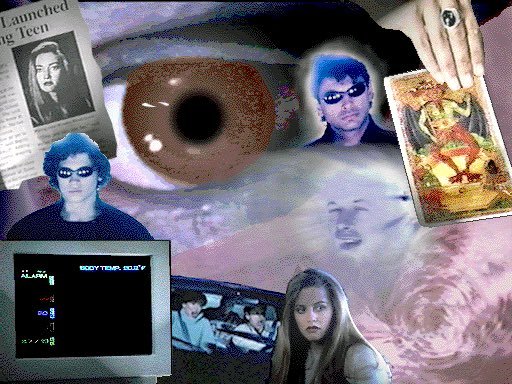
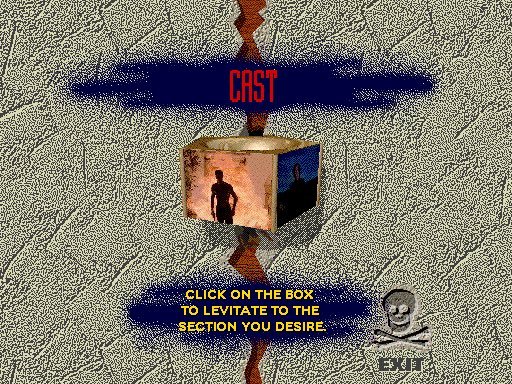

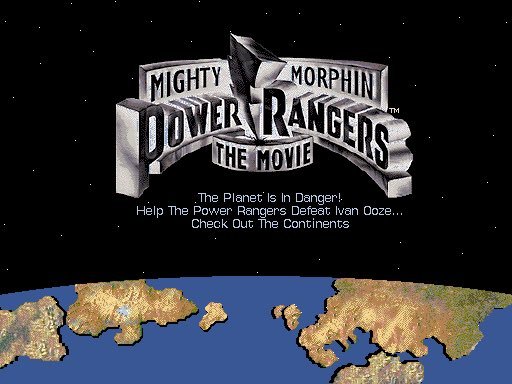
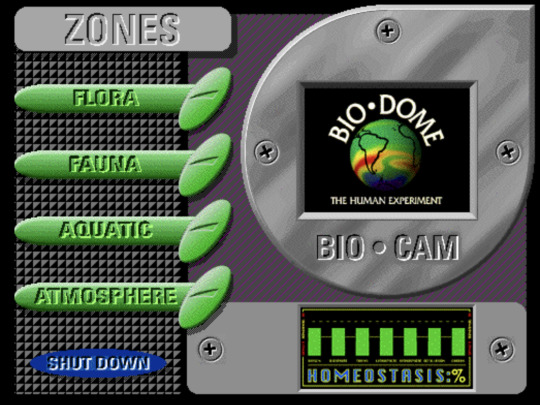
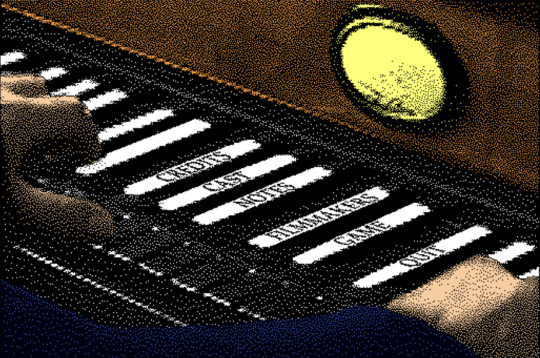
#internet archive#windows 3.1#old software#computer history#computing history#movie#movies#movie history#film history#press kit#multimedia#1994#1995#1996#1990s#90s
181 notes
·
View notes
Note
Hi! I'm so sorry if this has been asked before, but I'm completely clueless on computers, but I want to learn about them. Any places you'd recommend starting for bare bones beginners? I'm also interested in early-mid 90's tech particularly too. I'm guessing I have to figure out the basics before I can move onto specific tech though, right?
You're really knowledgeable and nice so I figured I'd just ask. Any help at all would be appreciated. Thank you! :]
That's an excellent question, I don't think I've been asked it before in such a general sense. I was raised with the benefit of being immersed in computers regularly, so providing a solid answer may be a bit difficult since for the basics, I never had to think about it.
I had computer classes of various types throughout my school years. We learned how to use a mouse, typing, word processing, programming -- and that was all before middle school. We got proper typing, html, and general purpose computer science courses in middle and high school, and you can bet I took those too. I also have the benefit of a bachelors of science in computer science, so you'll forgive me if my answer sounds incredibly skewed with 30+ years of bias.
The biggest suggestion I can give you is simply to find a device and play with it. Whatever you can get your hands on, even if its not that old, as long as it's considered past its prime, and nobody will get upset of you accidentally break something (physically or in software). Learning about things with computers in general tends to have some degree of trial and error, be it programming, administrating, or whatever -- try, learn, and start over if things don't work out as expected the first time. Professionals do it all the time (I know I do, and nobody's fired me for it yet).
Some cast-off 90s or early 00's surplus office desktop computer running Windows would be a good start, just explore it and its settings. Start digging into folders, see what's installed, see what works and more importantly what doesn't work right. Try to find comparable software, and install it. Even the basics like old copies of Microsoft Office, or whatever.
I recommend looking through the available software on winworld as it's an excellent treasure trove of operating systems, applications, games, and other useful software of the time period. I'd link it directly, but tumblr hates links to external sites and will bury this post if I do. If you're a mac fan, and you can find an old G3 or Performa, there is the Macintosh Garden's repository of software, but I'm not the right person to ask about that.
Some of you might be like "oh, oh! Raspberry Pi! say Raspberry Pi!" but I can't really recommend those as a starting point, even if they are cheap for an older model. Those require a bit of setup, and even the most common linux can be obtuse as hell for newcomers if you don't have someone to guide you.
If you don't have real hardware to muck about with, emulation is also your friend. DOSBox was my weapon of choice for a long time, but I think other things like 86Box have supplanted it. I have the luxury of the real hardware in most cases, so I haven't emulated much in the past decade. Tech Tangents on youtube has a new video explaining the subject well, I highly recommend it. There are plenty of other methods too, but most are far more sophisticated to get started with, if you ask me.
For getting a glimpse into the world of the 90s tech, if you haven't already discovered LGR on youtube, I've been watching his content for well over a decade now. He covers both the common and esoteric, both hardware and software, and is pretty honest about the whole thing, rather than caricaturish in his presentation style. It might be a good jumping off point to find proverbial rabbits to chase.
I guess the trick is to a find a specific thing you're really interested in, and then start following that thread, researching on wikipedia and finding old enthusiast websites to read through. I'm sure there are a few good books on more general history of 90s computing and the coming internet, but I'm not an avid reader of the genre. Flipping through tech magazines of the era (PC Magazine comes to mind, check archive dot org for that) can provide a good historical perspective. Watching old episodes of the Computer Chronicles (youtube or archive dot org) can provide this too, but it also had demonstrations and explanations of the emerging technologies as they happened.
There are so many approaches here, I'm sure I've missed some good suggestions though. I also realized I waffle a bit between the modern and vintage, but I find many computing troubleshooting skillsets transcend eras. What works now can apply to 10, 20, 30, or sometimes even 40+ years ago, because it's all about mindset of "this computer/program is dumb, and only follows the instructions its given" . Sometimes those instructions are poorly thought out on the part of the folks who designed them. And those failures are not necessarily your fault, so you gotta push through until you figure out how to do the thing you're trying to do. Reading the documentation you can find will only take you so far, sometimes things are just dumb, and experimentation (and failures) will teach you so much more about the hard and fast rules of computers than anything else. I'm rambling at this point...
So, let's throw the question to the crowd, and ask a few other folks in the Retrotech Crew.
@ms-dos5 @virescent-phosphor @teckheck @jhavard @techav @regretsretrotech @airconditionedcomputingnightmare @aperture-in-the-multiverse -- anything big I missed?
18 notes
·
View notes
Text
Here’s another archive site dedicated to old video games:

If you’ve got copies of old video games, you can submit them and provide documentation, as well! I’ve got a copy of the very first “Moorhuhn” game, which at that time came with the Johnny Walker logo and was exclusively distributed via internet cafes, that I want to donate soon.
Please check your media collections and contribute!

#I first have to set up a DOS emulator on Arch because I got a bunch of old disc that won't run on anything later than Windows 98#and VirtualBox is slowly ditching support for old OS VM's hence I need to get familiar with DOSBox first
99K notes
·
View notes
Text
Do you know what this is? Probably not. But if you follow me and enjoy retro gaming, you REALLY should know about it.
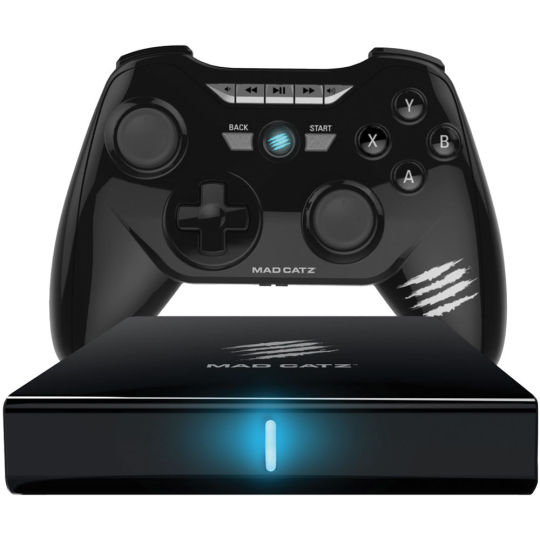
I see all of these new micro consoles, and retro re-imaginings of game consoles and I think to myself "Why?" WHY would you spend a decent chunk of your hard-earned money on some proprietary crap hardware that can only play games for that specific system?? Or even worse, pre-loaded titles and you can't download / add your own to the system!? Yet, people think it's great and that seems to be a very popular way to play their old favorites vs. emulation which requires a "certain degree of tech savvy" (and might be frowned upon from a legal perspective).
So, let me tell you about the Mad Catz M.O.J.O (and I don't think the acronym actually means anything). This came out around the same time as the nVidia Shield and the Ouya - seemingly a "me too" product from a company that is notorious for oddly shaped 3rd party game controllers that you would never personally use, instead reserved exclusively for your visiting friends and / or younger siblings. It's an Android micro console with a quad-core 1.8 GHz nVidia Tegra 4 processor, 2 GB of RAM, 16GB of onboard storage (expandable via SD card), running Android 4.2.2. Nothing amazing here from a hardware perspective - but here's the thing most people overlook - it's running STOCK Android - which means all the bloatware crap that is typically installed on your regular consumer devices, smartphones, etc. isn't consuming critical hardware resources - so you have most of the power available to run what you need. Additionally, you get a GREAT controller (which is surprising given my previous comment about the friend / sibling thing) that is a very familiar format for any retro-age system, but also has the ability to work as a mouse - so basically, the same layout as an Xbox 360 controller + 5 additional programmable buttons which come in very handy if you are emulating. It is super comfortable and well-built - my only negative feedback is that it's a bit on the "clicky" side - not the best for environments where you need to be quiet, otherwise very solid.
Alright now that we've covered the hardware - what can it run? Basically any system from N64 on down will run at full speed (even PSP titles). It can even run an older version of the Dreamcast emulator, Reicast, which actually performs quite well from an FPS standpoint, but the emulation is a bit glitchy. Obviously, Retroarch is the way to go for emulation of most older game systems, but I also run DOSbox and a few standalone emulators which seem to perform better vs. their RetroArch Core equivalents (list below). I won't get into all of the setup / emulation guide nonsense, you can find plenty of walkthroughs on YouTube and elsewhere - but I will tell you from experience - Android is WAY easier to setup for emulation vs. Windows or another OS. And since this is stock Android, there is very little in the way of restrictions to the file system, etc. to manage your setup.
I saved the best for last - and this is truly why you should really check out the M.O.J.O. even if you are remotely curious. Yes, it was discontinued years ago (2019, I think). It has not been getting updates - but even so, it continues to run great, and is extremely reliable and consistent for retro emulation. These sell on eBay, regularly for around $60 BRAND NEW with the controller included. You absolutely can't beat that for a fantastic emulator-ready setup that will play anything from the 90s without skipping a beat. And additional controllers are readily available, new, on eBay as well.
Here's a list of the systems / emulators I run on my setup:
Arcade / MAME4droid (0.139u1) 1.16.5 or FinalBurn Alpha / aFBA 0.2.97.35 (aFBA is better for Neo Geo and CPS2 titles bc it provides GPU-driven hardware acceleration vs. MAME which is CPU only)
NES / FCEUmm (Retroarch)
Game Boy / Emux GB (Retroarch)
SNES / SNES9X (Retroarch)
Game Boy Advance / mGBA (Retroarch)
Genesis / PicoDrive (Retroarch)
Sega CD / PicoDrive (Retroarch)
32X / PicoDrive (Retroarch)
TurboGrafx 16 / Mednafen-Beetle PCE (Retroarch)
Playstation / ePSXe 2.0.16
N64 / Mupen64 Plus AE 2.4.4
Dreamcast / Reicast r7 (newer versions won't run)
PSP / PPSSPP 1.15.4
MS-DOS / DOSBox Turbo + DOSBox Manager
I found an extremely user friendly Front End called Gamesome (image attached). Unfortunately it is no longer listed on Google Play, but you can find the APK posted on the internet to download and install. If you don't want to mess with that, another great, similar Front End that is available via Google Play is called DIG.
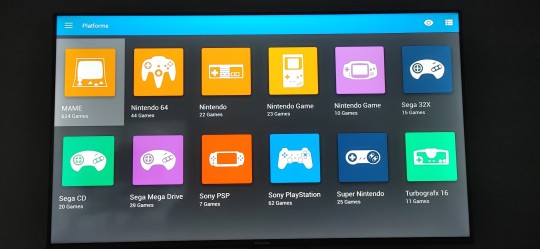
If you are someone who enjoys emulation and retro-gaming like me, the M.O.J.O. is a great system and investment that won't disappoint. If you decide to go this route and have questions, DM me and I'll try to help you if I can.
Cheers - Techturd
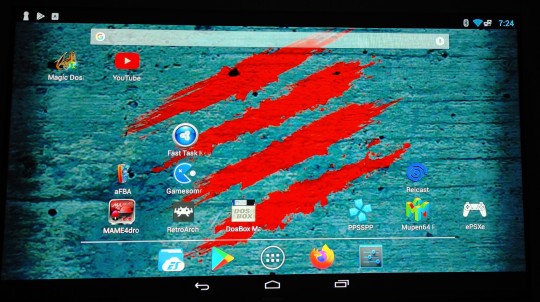
#retro gaming#emulation#Emulators#Android#Nintendo#Sega#Sony#Playstation#N64#Genesis#Megadrive#Mega drive#32x#Sega cd#Mega cd#turbografx 16#Pc engine#Dos games#ms dos games#ms dos#Psp#Snes#Famicom#super famicom#Nes#Game boy#Gameboy#gameboy advance#Dreamcast#Arcade
67 notes
·
View notes
Text
ive become slightly addicted 2 emulating old games and currently im trying to figure out how to run stuart little's learning adventures (2002).... i just do not have the brain capacity right now to figure out how to set up a dosbox
#vv.txt#maybe some other day.... when ive taken my adhd meds or something#i played them on my grandpa's old laptop when i was a kid and i want to show my partner bc the games are very cute#but im not quite ready to figure this out yet. i might have to mostly stick to nintendo gb thru 3ds games so far#cant get the switch or gamecube emulators working yet but i hope i can figure it out#trying to get viva pinata on the desktop now since xenia doesnt have a working linux build it seems
1 note
·
View note
Text
Retro computer emulation/virtualization resources
Not too long ago, it was one of my hobbies to recreate and emulate old machines and try to use them in a somewhat 'legit' way in order to experience how using them in an accurate time-period might have felt like. While it's always better to use a real machine, it's also important to note that time-accurate machines are essentially a 'ticking bomb'. Some of the electronics inside can go bad at any given time, like capacitors, and other critical components might also go bad due to humidity, moisture in the air, changes in temperature, etc. Plus, they are not always cheap and they take space that you might not have.
This is why I prefer using emulators and virtualization software in order to virtualize a time-period accurate machine that I can use. This is the software I found that I like the most, and what systems I use them for.
DOSbox-X

This is a modified version of DOSBox that includes support for multiple video devices including 3dfx emulation (Voodoo), networking, and even printer support (emulated, but AFAIK it only prints in black and white). It's perfect for MS-DOS and Windows (1-3.11) emulation. Technically you could even install Windows 95 in it.
86-box

This is the way to go if you want to emulate old retro systems. No questions. The best part of it is how flexible it is. You can select the motherboard, the processor you want to emulate, the video card, you can also enable 3dfx support up to the Voodoo 2 (but it also emulates a Voodoo3 and the Banshee), sound card, literally every detail. It's like building a PC, but virtually. And it has hardware from the old 8086 IBM PCs to more modern Pentium 2 machines. It also has network and printer support.
The downside is that since it's low-level emulation, you need a 'beefy' CPU with very good single thread performance in order for more modern systems like Windows 9x and ME to run more smoothly. Another flaw is that for some reason the FP emulation for older processors doesn't work properly for some reason, so you might prefer to use DOSBox-X if you want DOS emulation. The 3dfx emulation is also 'so-so' and not very great, but it works.
It also requires valid ROMs, but you can search for a valid ROMset online (check Github) if you want to use it. For legal reasons, I can't provide links to them, but they are not hard to find.
VMWare Workstation Player

I choose VMWare over other virtualization solutions because of it's graphic drivers capable of running relatively new games from the mid 2000s, and because unlike VirtualBox (since version 6) it still supports old Windows versions, including XP, 9x, ME and old NT systems.
Broadcom wants you to buy a license for the Pro version so they hide the links to the free Workstation Player version. But they are still available and they even release updates once in a while (yes, it's free of charge).
In the link I'm providing, go to the 'player' folder and select the latest version (higher number, now it's 17.6.1) and your system to download VMWare Workstation Player. Then go to the 'ws' folder and select the same version and system, but then select 'packages' to download a matching copy of vmware tools.
Finding software
If you need software, there are three places you need to look for. One is archive.org, the other is WinWorld PC, and the other is Vetusware (requires an account). I can't provide links so search for them on your own. I also browse sites like oldversion.com, but I don't trust these too much, so go at your own risk (or better yet, don't). Naturally you should always buy the software you use, whenever it's possible, and use backups of your legally owned software.
Did you like this post?
I will make more posts in the future about how to set up these emulated machines and how I work with them.
2 notes
·
View notes
Text
That counts. Compare the last official DOSBox feature release (0.74) to DOSBox-X: It's night and fucking day.
Hell, since DOSBox-X emulates PC98/Win3.x/Win95 systems too, it's literally MORE systems!
Fun fact:
This latest DOSBox feature release is older (14 years) than the entire run of DOS releases from Microsoft (1981-1994: 13 years)
you're not a REAL GAMER unless you have multiple emulators for the same system installed
390 notes
·
View notes
Note
(the return of prev anon) JAYDEN THANK YOU FOR SAYING THAT ACTUALLY. because apparently i don't know how to think?? i've never used DOSBox in particular, but i have no clue in the world why i hadn't tried to run it through any of my other emulators, old computer shit is literally part of my special interest so i have um. a Silly amount of emulators on my external hard drive. hopefully it works, i've had a hard time with emulators refusing to acknowledge my external cd drive before. ohh when i manage to find that hard drive so help me guy towers i am going to Get You. (and others, probably. because despite having compatibility modes for 95, this thing can't seem to launch anything pre-98. but mostly guy.)
I'm glad I was able to help! (I was barely more than rubberducking so I won't take too much credit)
I'm able to get Vol. 1, XL (yeah they're seperate files in DOSBox despite being almost the same game), Sports, Vol. 2, Movies, TV, and Vol. 3 to work through DOSBox; Headrush, The Ride, Offline, and L!F!F! work on their own; I'm still messing with 5th Dementia but CAN get unmucky audio through the current emulator I'm using, and I still do not have Fools Gold or UK. One day.
2 notes
·
View notes
Text
Shadow Warrior (1997)
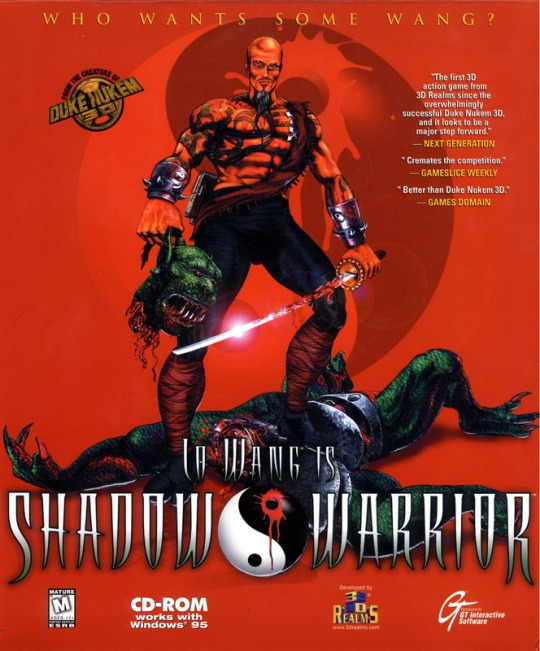
Shadow Warrior is a 1997 first-person shooter developed by 3D Realms. It’s essentially their immediate follow-up to their previous game, Duke Nukem 3D released the previous year. It’s very similar to their previous game in many ways, it’s another first-person shooter using the Build engine. A lot of what I said about Duke Nukem 3D applies to this game.
What is more distinct about Shadow Warrior is that the developers at 3D Realms were more familiar with the Build engine and thus able to push its limits even further. The faking of room-over-room is more sophisticated in this game. For example, water surfaces are now transparent, hiding the teleports going from the surface to below water even better. And Shadow Warrior might be the first FPS to feature sections where you could drive vehicles and use gun turrets. Keep in mind, this was four years before Halo. And weapons feature alternate fire modes that you could use by right-clicking, another innovation that would become standard in the years to come. Another minor innovation that would become ubiquitous is that there are useable ladders.
There isn’t much else to say, it’s similar solid boomer shooter action compared to 3D Realms’ previous game. If you liked Duke Nukem 3D, you’ll probably enjoy Shadow Warrior.
And liking Duke Nukem 3D might also mean you are able to stomach some painful 90s cis white dude humor, which kinda is a prerequisite for enjoying Shadow Warrior too.
It’s honestly quite a bit worse, mostly because this game ends orientalist/racist humor to the mix. If Duke Nukem is a parody of 80s action movies, Shadow Warrior is a parody of kung-fu movies, and also pop culture ninjas and anime. If that mix sounds like a weird mash-up of Chinese and Japanese culture, that’s becauseit literally is. This game stars Lo Wang, a horny old chinese man who seems right out of a Hong Kong martials arts movie, but actually he is a ninja who lives and works in Japan. He even has a katana and shurikens as weapons. He is voiced by a white man* doing a stereotypical chinese accent. It’s just as stereotypical and offensive as you might think, and popular white American impressions of Chinese and Japanese pop culture are mixed together into an one big “Asian” joke. Lo Wang’s name is basically just one recurring dick joke. The sexy naked women from Duke Nukem return, but this time the sprites are drawn in an anime-style.
(*The white man in question was the late voice actor John Galt. It turns out the real answer to “Who is John Galt?” is “the voice of Lo Wang in Shadow Warrior” although Galt was born before Atlas Shrugged was written.)
It’s no surprise that Duke Nukem has endured as a character, being memed about to this day, and people like Clint LGR or Gianni Matragrano have great fun doing their Jon St. John as Duke Nukem impression in youtube videos, while Lo Wang is kinda forgotten. If a gaming youtuber did a Lo Wang impression today it would be a scandal, and rightly so. This is despite Shadow Warrior unlike Duke Nukem having a succesful reboot series starting in 2013, with the third game in the reboot series released as recently in 2022. But the 2013 reboot reimagined Lo Wang pretty much beyond all recognition, precisely because of all the racial stereotyping in the original.
The original game does have some solid action gameplay though. And I do appreciate some of the gunplay in this game. You get a missile launcher, basically the standard FPS RPG weapon, except one of its alternate firemode is literally a tactical nuke. You can easily kill yourself with it, and the only viable method of using it is firing it and hiding behind a corner to avoid getting hurt by the blast. It’s amazing. I can’t fully condemn an FPS game that allows you to carry and use nukes. To quote Lo Wang himself when he picks a nuke up. “I like nuclear weapons” (in games).
The original Shadow Warrior is now available free of charge on GOG. And you can use dosbox to emulate MS-DOS, but a better alternative is the sourceport VoidSW which is based on and is included with downloads of the Duke Nukem 3D sourceport eduke32.
2 notes
·
View notes
Text
Hi-Octane (DOS, Bullfrog Productions, 1995)
You can download it for use in DOSBox here, or download it pre-packaged with it (or, alternatively, emulated PS1 and Saturn versions) here.



#internet archive#dos#dos games#game#games#video game#video games#videogame#videogames#computer game#computer games#obscure games#racing games#retro games#retro gaming#retro graphics#game history#video game history#gaming history#1995#1990s#90s
9 notes
·
View notes
Text

Mystic Square mentions returning to DOS and the manual for Lotus Land Story says it requires MS-DOS. Maybe it would work if I got it running on DOSBOX?
I've been troubleshooting Touhou Project 4 Lotus Land story to figure out why I'm freezing at Yuuka Kazami. I've been running the game with Neko Project 21. The default settings for the game cause a lot of lag for me, so I have to change them. I've been changing the memory to 640kb rather than default 1.6mb to and found reduced lag and have also lowered the cpu cycles and maxxed the soundrate. While this greatly reduces lag, with these settings I'm freezing at Yuuka.
Just ran through the game with 1.6mb RAM with moderately reduced CPU cycles and 55k sound rate and this has let me fight Yuuka at the cost of lag. 640kb should already have been over the requirements, so I don't know why it causes freezing. The game's review thing said I wasn't experiences slowdown.
5 notes
·
View notes
Text
Overview LaunchBox LaunchBox began as a fantastic frontend for DOSBox, but it has since evolved to support not only retro DOS games but also modern PC games and emulated consoles. It’s the perfect hub for…
#anya mouthwashing#agatha harkness#batman#bucktommy#artists on tumblr#captain curly#cats of tumblr#911 abc
1 note
·
View note